Journal Description
Galaxies
Galaxies
is an international, peer-reviewed, open access journal on astronomy, astrophysics, and cosmology published bimonthly online by MDPI.
- Open Access— free for readers, with article processing charges (APC) paid by authors or their institutions.
- High Visibility: indexed within Scopus, ESCI (Web of Science), Astrophysics Data System, INSPIRE, Inspec, and other databases.
- Journal Rank: JCR - Q2 (Astronomy and Astrophysics) / CiteScore - Q2 (Astronomy and Astrophysics)
- Rapid Publication: manuscripts are peer-reviewed and a first decision is provided to authors approximately 19.9 days after submission; acceptance to publication is undertaken in 4.9 days (median values for papers published in this journal in the second half of 2024).
- Recognition of Reviewers: reviewers who provide timely, thorough peer-review reports receive vouchers entitling them to a discount on the APC of their next publication in any MDPI journal, in appreciation of the work done.
Impact Factor:
3.2 (2023);
5-Year Impact Factor:
2.5 (2023)
Latest Articles
Exploring the GRB–Supernova Connection: Does a Superluminous Hypernova Population Exist?
Galaxies 2025, 13(3), 57; https://doi.org/10.3390/galaxies13030057 - 6 May 2025
Abstract
Observations of several gamma-ray bursts (GRBs) that are temporally and spatially compatible with energetic supernovae (hypernovae) have established their common origin. In one case (GRB 111209A/SN 2011kl), the associated supernova was classified as superluminous (SN 2011kl). The exceptional duration of the observed gamma-ray
[...] Read more.
Observations of several gamma-ray bursts (GRBs) that are temporally and spatially compatible with energetic supernovae (hypernovae) have established their common origin. In one case (GRB 111209A/SN 2011kl), the associated supernova was classified as superluminous (SN 2011kl). The exceptional duration of the observed gamma-ray prompt emission of GRB 111209A (about 7 h) is widely considered key to unlocking the physics behind the still mysterious origin of superluminous supernovae (SLSNe). We review the main observational and theoretical findings that may link some ultra-long GRBs to SLSNe. Specifically, we examine notable events and the role of progenitors and host galaxies in shaping these phenomena and focus on the proposed models. While a magnetar central engine is a plausible mechanism for both luminous and long-duration GRBs, a conclusive answer remains elusive, as alternative explanations are still viable. Further observational and theoretical work is required to clarify progenitor pathways and explosion mechanisms, potentially extending the classical GRB-SN connection to rare superluminous hypernovae.
Full article
(This article belongs to the Special Issue Gamma-Ray Bursts in Multiwavelength: Theory, Observational Correlations and GRB Cosmology)
►
Show Figures
Open AccessArticle
Spectral Variability of Herbig Ae Star V1295, Aquila
by
Hemayil Adigozalzade, Silva Jarvinen, Swetlana Hubrig, Ulviyya Bashirova and Nariman Ismailov
Galaxies 2025, 13(3), 56; https://doi.org/10.3390/galaxies13030056 - 6 May 2025
Abstract
This article presents the results of long-term spectral studies of the unusual Herbig Ae star V1295 Aql. The variability in the spectrophotometric parameters of the emission and absorption components of the hydrogen lines Hα, Hβ, and D Na I—and of various metallic lines—is
[...] Read more.
This article presents the results of long-term spectral studies of the unusual Herbig Ae star V1295 Aql. The variability in the spectrophotometric parameters of the emission and absorption components of the hydrogen lines Hα, Hβ, and D Na I—and of various metallic lines—is studied. The periodic variability in these parameters over a period of 51.7 days, recently established using mean longitudinal magnetic field measurements, is confirmed. The obtained average value of the radial velocities of metal absorption lines is Vr = 0.75 ± 1.85 km/s. According to our long-term observations, the radial velocities of the star do not change over time. This indicates the absence of a close stellar-mass companion.
Full article
(This article belongs to the Special Issue Circumstellar Matter in Hot Star Systems)
►▼
Show Figures
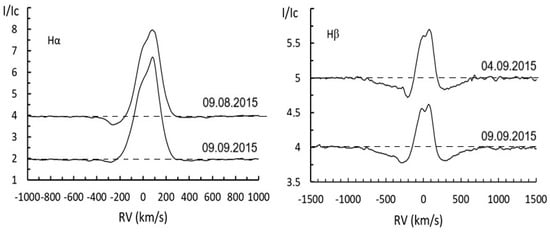
Figure 1
Open AccessArticle
Time Dilation Observed in Type Ia Supernova Light Curves and Its Cosmological Consequences
by
Václav Vavryčuk
Galaxies 2025, 13(3), 55; https://doi.org/10.3390/galaxies13030055 - 3 May 2025
Abstract
The cosmic time dilation observed in Type Ia supernova light curves suggests that the passage of cosmic time varies throughout the evolution of the Universe. This observation implies that the rate of proper time is not constant, as assumed in the standard FLRW
[...] Read more.
The cosmic time dilation observed in Type Ia supernova light curves suggests that the passage of cosmic time varies throughout the evolution of the Universe. This observation implies that the rate of proper time is not constant, as assumed in the standard FLRW metric, but instead is time-dependent. Consequently, the commonly used FLRW metric should be replaced by a more general framework, known as the Conformal Cosmology (CC) metric, to properly account for cosmic time dilation. The CC metric incorporates both spatial expansion and time dilation during cosmic evolution. As a result, it is necessary to distinguish between comoving and proper (physical) time, similar to the distinction made between comoving and proper distances. In addition to successfully explaining cosmic time dilation, the CC metric offers several further advantages: (1) it preserves Lorentz invariance, (2) it maintains the form of Maxwell’s equations as in Minkowski spacetime, (3) it eliminates the need for dark matter and dark energy in the Friedmann equations, and (4) it successfully predicts the expansion and morphology of spiral galaxies in agreement with observations.
Full article
(This article belongs to the Special Issue Cosmology and the Quantum Vacuum—2nd Edition)
►▼
Show Figures
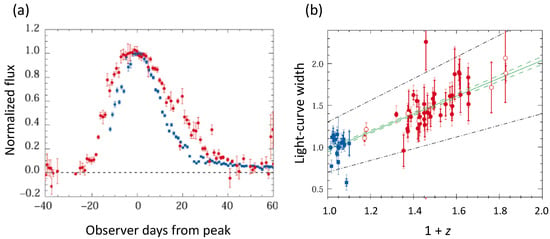
Figure 1
Open AccessArticle
The Effect of Viscosity on the Temperature of Ae Star Disks
by
R. Anusha and T. A. A. Sigut
Galaxies 2025, 13(3), 54; https://doi.org/10.3390/galaxies13030054 - 3 May 2025
Abstract
This study explores the impact of viscous heating on decretion disks around Classical Ae (CAe) stars, with a focus on modeling the disk’s thermal structure. While photoionization is the dominant heating mechanism, viscous dissipation can play an important role in shaping the disk
[...] Read more.
This study explores the impact of viscous heating on decretion disks around Classical Ae (CAe) stars, with a focus on modeling the disk’s thermal structure. While photoionization is the dominant heating mechanism, viscous dissipation can play an important role in shaping the disk temperature, particularly for cooler CAe subtypes. Our models incorporate viscosity-driven heating and predict that shear heating has a negligible effect for early A-type stars (A0–A1), but it becomes increasingly significant for later spectral types, especially as the viscosity parameter (
(This article belongs to the Special Issue Circumstellar Matter in Hot Star Systems)
►▼
Show Figures

Figure 1
Open AccessReview
Very-High-Energy Gamma-Ray Observations as a Probe to the Nature of Dark Matter and Prospects for MACE
by
Mani Khurana, Krishna Kumar Singh, Atul Pathania, Pawan Kumar Netrakanti and Kuldeep Kumar Yadav
Galaxies 2025, 13(3), 53; https://doi.org/10.3390/galaxies13030053 - 2 May 2025
Abstract
►▼
Show Figures
Searching for very-high-energy photons arising from dark matter interactions in selected astrophysical environments is a promising strategy to probe the existence and particle nature of dark matter. Among the many particle candidates, motivated by the extensions of the Standard Model, Weakly Interacting Massive
[...] Read more.
Searching for very-high-energy photons arising from dark matter interactions in selected astrophysical environments is a promising strategy to probe the existence and particle nature of dark matter. Among the many particle candidates, motivated by the extensions of the Standard Model, Weakly Interacting Massive Particles (WIMPs) are considered the most compelling candidate for the elusive dark matter in the universe. In this contribution, we report an overview of the important developments in the field of indirect searching for dark matter through cosmic gamma-ray observations. We mainly focus on the role of atmospheric Cherenkov telescopes in probing the dark matter. Finally, we emphasize the opportunities for the Major Atmospheric Cherenkov Experiment (MACE) situated in Hanle, India, to explore WIMPs in the mass range of 200 GeV to 10 TeV for Segue1 and Draco dwarf–spheroidal galaxies.
Full article
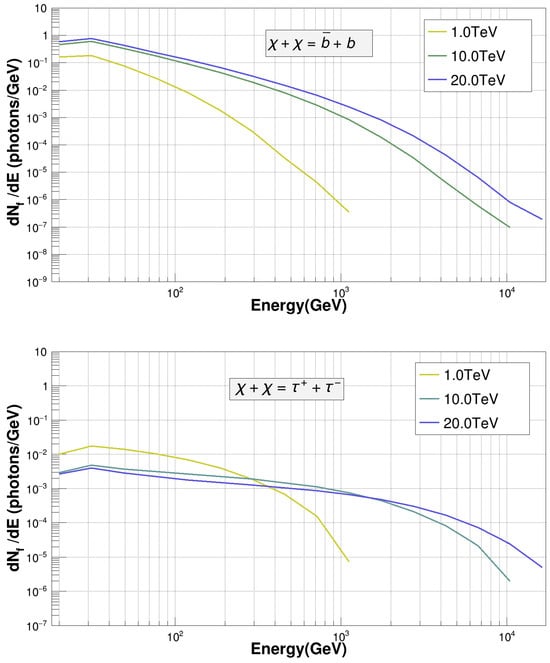
Figure 1
Open AccessFeature PaperArticle
Statistical Classification and an Optimized Red-Sequence Technique for the Determination of Galaxy Clusters
by
Dagoberto R. Mares-Rincón, Josué J. Trejo-Alonso, José A. Guerrero-Díaz-de-León and Jorge E. Macías-Díaz
Galaxies 2025, 13(3), 52; https://doi.org/10.3390/galaxies13030052 - 1 May 2025
Abstract
►▼
Show Figures
This study presents a novel method for characterizing galaxy clusters by integrating statistical classification techniques with an optimized adaptation of the red sequence approach. The proposed algorithm employs Gaussian mixture models to analyze the distribution of three key variables: r magnitude,
[...] Read more.
This study presents a novel method for characterizing galaxy clusters by integrating statistical classification techniques with an optimized adaptation of the red sequence approach. The proposed algorithm employs Gaussian mixture models to analyze the distribution of three key variables: r magnitude,
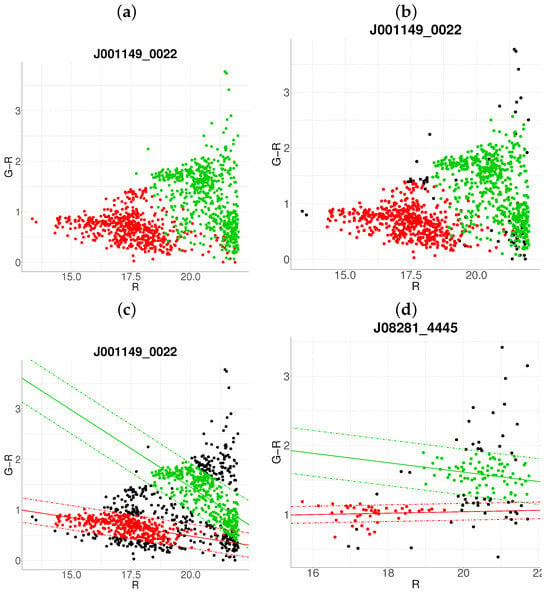
Figure 1
Open AccessArticle
The Galactic Pizza: Flat Rotation Curves in the Context of Cosmological Time-Energy Coupling
by
Artur Novais and André L. B. Ribeiro
Galaxies 2025, 13(3), 51; https://doi.org/10.3390/galaxies13030051 - 27 Apr 2025
Abstract
The phenomenon of augmented gravity on the scale of galaxies, conventionally attributed to dark matter halos, is shown to possibly result from the incremental growth of galactic masses and radii over time. This approach elucidates the cosmological origins of the acceleration scale
[...] Read more.
The phenomenon of augmented gravity on the scale of galaxies, conventionally attributed to dark matter halos, is shown to possibly result from the incremental growth of galactic masses and radii over time. This approach elucidates the cosmological origins of the acceleration scale
(This article belongs to the Special Issue Alternative Interpretations of Observed Galactic Behaviors)
►▼
Show Figures

Figure 1
Open AccessReview
Betelgeuse, the Prototypical Red Supergiant
by
Andrea K. Dupree and Miguel Montargès
Galaxies 2025, 13(3), 50; https://doi.org/10.3390/galaxies13030050 - 24 Apr 2025
Abstract
The behavior of the bright red supergiant, Betelgeuse, is described with results principally from the past 6 years. The review includes imaging, photometry, and spectroscopy to record the Great Dimming of 2019–2020. This event was followed by a slow ongoing recovery from the
[...] Read more.
The behavior of the bright red supergiant, Betelgeuse, is described with results principally from the past 6 years. The review includes imaging, photometry, and spectroscopy to record the Great Dimming of 2019–2020. This event was followed by a slow ongoing recovery from the massive surface mass ejection after which the stellar characteristics changed. Theoretical simulations address the cause of this episodic mass ejection and the optical Dimming. Recent publications evaluating the perplexing 2100 day periodicity in the star’s brightness and radial velocity provide evidence that Betelgeuse may harbor a companion object. Current attempts at direct detection of this companion are discussed. Betelgeuse provides a well-studied and meaningful example for supergiant stars in our Galaxy and others.
Full article
(This article belongs to the Special Issue The Red Supergiants: Crucial Signposts for the Fate of Massive Stars)
►▼
Show Figures

Figure 1
Open AccessReview
Symbiotic Stars in the Era of Modern Ground- and Space-Based Surveys
by
Jaroslav Merc
Galaxies 2025, 13(3), 49; https://doi.org/10.3390/galaxies13030049 - 23 Apr 2025
Abstract
Symbiotic stars, interacting binaries composed of a cool giant and a hot compact companion, exhibit complex variability across the electromagnetic spectrum. Over the past decades, large-scale photometric and spectroscopic surveys from ground- and space-based observatories have significantly advanced their discovery and characterization. These
[...] Read more.
Symbiotic stars, interacting binaries composed of a cool giant and a hot compact companion, exhibit complex variability across the electromagnetic spectrum. Over the past decades, large-scale photometric and spectroscopic surveys from ground- and space-based observatories have significantly advanced their discovery and characterization. These datasets have transformed the search for new symbiotic candidates, providing extensive time-domain information crucial for their classification and analysis. This review highlights recent observational results that have expanded the known population of symbiotic stars, refined classification criteria, and enhanced our understanding of their variability. Despite these advances, fundamental questions remain regarding their long-term evolution, mass transfer and accretion processes, or their potential role as progenitors of Type Ia supernovae. With ongoing and upcoming surveys, the coming years promise new discoveries and a more comprehensive picture of these intriguing interacting systems.
Full article
(This article belongs to the Special Issue Circumstellar Matter in Hot Star Systems)
►▼
Show Figures
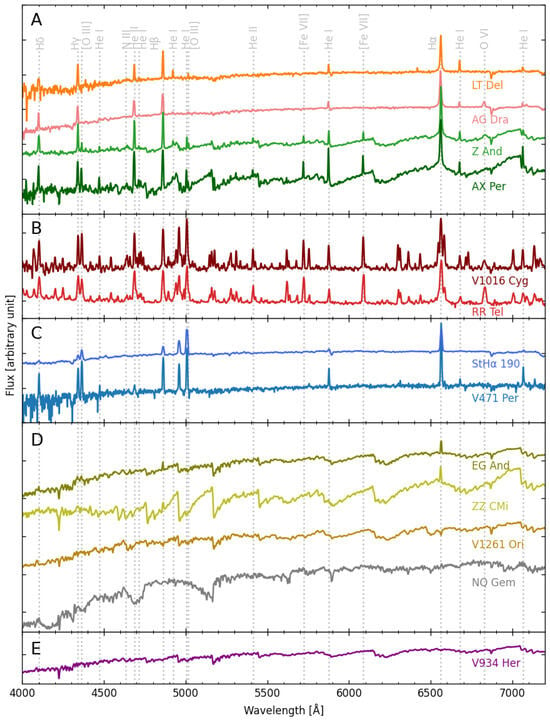
Figure 1
Open AccessArticle
Necessary Conditions for Earthly Life Floating in the Venusian Atmosphere
by
Jennifer J. Abreu, Alyxander R. Anchordoqui, Nyamekye J. Fosu, Michael G. Kwakye, Danijela Kyriakakis, Krystal Reynoso and Luis A. Anchordoqui
Galaxies 2025, 13(3), 48; https://doi.org/10.3390/galaxies13030048 - 22 Apr 2025
Abstract
►▼
Show Figures
Millimeter-waveband spectra of Venus from both the James Clerk Maxwell Telescope (JCMT) and the Atacama Large Millimeter/submillimeter Array (ALMA) seem to indicate there may be evidence (signal-to-noise ratio of about 15σ) of a phosphine absorption-line profile against the thermal background from deeper, hotter
[...] Read more.
Millimeter-waveband spectra of Venus from both the James Clerk Maxwell Telescope (JCMT) and the Atacama Large Millimeter/submillimeter Array (ALMA) seem to indicate there may be evidence (signal-to-noise ratio of about 15σ) of a phosphine absorption-line profile against the thermal background from deeper, hotter layers of the atmosphere. Phosphine is an important biomarker; e.g., the trace of phosphine in the Earth’s atmosphere is unequivocally associated with anthropogenic activity and microbial life (which produces this highly reducing gas even in an overall oxidizing environment). Motivated by the JCMT and ALMA tantalizing observations, we reexamine whether Venus could accommodate Earthly life. More concretely, we hypothesize that the microorganisms populating the Venusian atmosphere are not free floating but confined to the liquid environment inside cloud aerosols or droplets. Armed with this hypothesis, we generalize a study of airborne germ transmission to constrain the maximum size of droplets that could be floating in the Venusian atmosphere by demanding that their Stokes fallout times to reach moderately high temperatures are pronouncedly larger than the microbe’s replication time. We also comment on the effect of cosmic ray showers on the evolution of aerial microbial life.
Full article
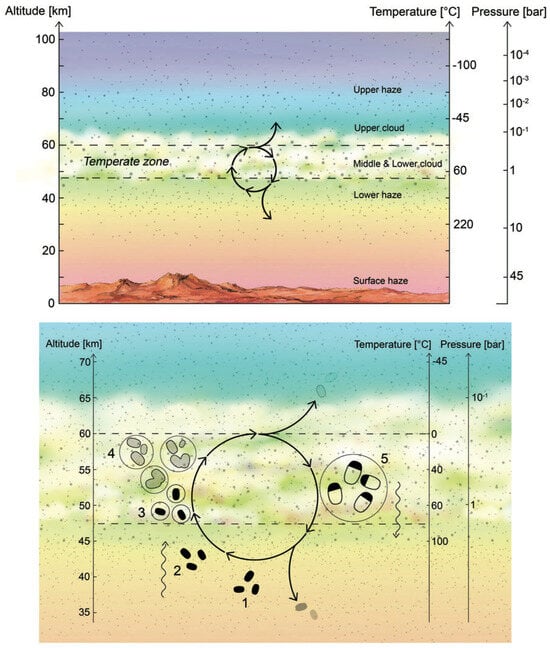
Figure 1
Open AccessArticle
Fundamental Parameters and Evolutionary Scenario of HD 327083
by
Nadezhda L. Vaidman, Anatoly S. Miroshnichenko, Sergey V. Zharikov, Serik A. Khokhlov, Aldiyar T. Agishev and Berik S. Yermekbayev
Galaxies 2025, 13(3), 47; https://doi.org/10.3390/galaxies13030047 - 22 Apr 2025
Abstract
In this study, we present refined orbital and fundamental parameters of the Galactic B[e] supergiant binary system HD 327083 using the Bayesian Markov Chain Monte Carlo (MCMC) method applied to the radial velocities data of HD 327083. We found that the system is
[...] Read more.
In this study, we present refined orbital and fundamental parameters of the Galactic B[e] supergiant binary system HD 327083 using the Bayesian Markov Chain Monte Carlo (MCMC) method applied to the radial velocities data of HD 327083. We found that the system is well described by a circular orbital model with the mass ratio of the components of
(This article belongs to the Special Issue Circumstellar Matter in Hot Star Systems)
►▼
Show Figures
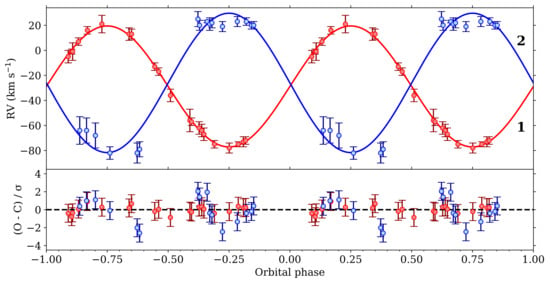
Figure 1
Open AccessReview
Intermediate-Mass Mergers: A New Scenario for Several FS CMa Stars
by
Daniela Korčáková, Nela Dvořáková, Iris Bermejo Lozano, Gregg A. Wade, Alicia Moranchel Basurto, Pavel Kroupa, Raul Ortega Chametla, Colin Peter Folsom and Ondrej Juhás
Galaxies 2025, 13(3), 46; https://doi.org/10.3390/galaxies13030046 - 22 Apr 2025
Abstract
We summarise the properties and nature of a peculiar group of B-type stars called FS CMa stars. These stars show the B[e] phenomenon, i.e., their spectra exhibit both forbidden emission lines and infrared excess. Such properties point to an extended circumstellar gas and
[...] Read more.
We summarise the properties and nature of a peculiar group of B-type stars called FS CMa stars. These stars show the B[e] phenomenon, i.e., their spectra exhibit both forbidden emission lines and infrared excess. Such properties point to an extended circumstellar gas and dust component. Although the phenomenon has been explained in most B[e] stars, the origin and nature of FS CMa stars is disputed. Here, we focus on the merger hypothesis, for which evidence has recently been discovered.
Full article
(This article belongs to the Special Issue Circumstellar Matter in Hot Star Systems)
►▼
Show Figures

Figure 1
Open AccessArticle
Numerical Study of Bar Suppression in Galaxy Models Due to Disc Heating
by
Alejandro López Gómez, Ruslan Gabbasov and Isaura Luisa Fuentes-Carrera
Galaxies 2025, 13(2), 45; https://doi.org/10.3390/galaxies13020045 - 21 Apr 2025
Abstract
The process of bar formation, evolution and destruction is still a controversial topic regarding galaxy dynamics. Numerical simulations show that these phenomena strongly depend on physical and numerical parameters. In this work, we study the combined influence of the softening parameter,
The process of bar formation, evolution and destruction is still a controversial topic regarding galaxy dynamics. Numerical simulations show that these phenomena strongly depend on physical and numerical parameters. In this work, we study the combined influence of the softening parameter,
(This article belongs to the Special Issue From Tides to Waves: Understanding the Formation Mechanisms of Galactic Spirals)
►▼
Show Figures
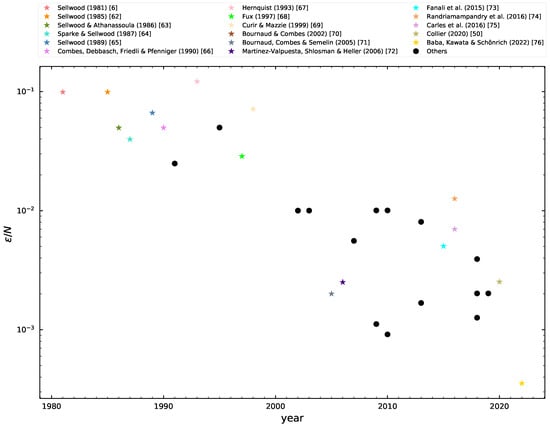
Figure 1
Open AccessArticle
Examination of the Functional Form of the Light and Mass Distribution in Spiral Arms
by
Ilia V. Chugunov, Alexander A. Marchuk and Sergey S. Savchenko
Galaxies 2025, 13(2), 44; https://doi.org/10.3390/galaxies13020044 - 19 Apr 2025
Abstract
Spiral arms are a common feature of local galaxies, but the exact form of the distribution of mass and light in them is not well known. In this work, we aim to measure this distribution as accurately as possible, focusing on individual spiral
[...] Read more.
Spiral arms are a common feature of local galaxies, but the exact form of the distribution of mass and light in them is not well known. In this work, we aim to measure this distribution as accurately as possible, focusing on individual spiral arms and using the so-called slicing method. The sample consists of 19 well-resolved, viewed face-on spiral galaxies from the S4G survey. We work primarily with infrared images at 3.6 μm from the same survey and, secondarily, with ultraviolet data from the GALEX telescope. We derive the properties of the spiral arms step by step, starting from their overall shape, then measuring their brightness profile and width variation along the arm and then examining the fine structure of the profile across the arm, namely, its skewness and Sérsic index. We construct a 2D photometric function of the spiral arm that can be used in further decomposition studies, validate it and identify the most and least important parameters. Finally, we show how our results can be used to unravel the nature of the spiral arms, supporting the evidence that NGC 4535 has a density wave in its disc.
Full article
(This article belongs to the Special Issue From Tides to Waves: Understanding the Formation Mechanisms of Galactic Spirals)
►▼
Show Figures
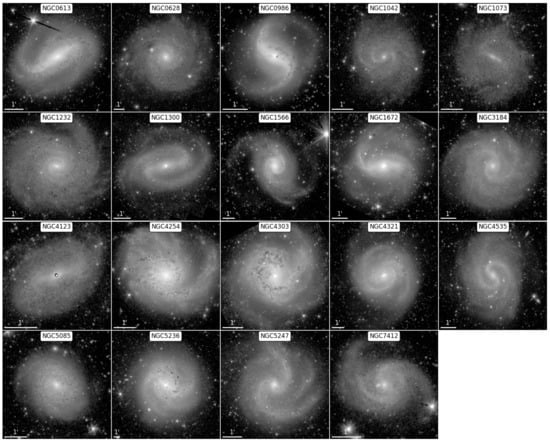
Figure 1
Open AccessReview
Red and Yellow Hypergiants
by
Terry Jones
Galaxies 2025, 13(2), 43; https://doi.org/10.3390/galaxies13020043 - 18 Apr 2025
Abstract
The red and yellow hypergiants are a rare and important phase in the evolution of the most massive stars that can reach the cool part of the HR Diagram. The hypergiant phase is commonly characterized by high, often episodic mass-loss rates and significant
[...] Read more.
The red and yellow hypergiants are a rare and important phase in the evolution of the most massive stars that can reach the cool part of the HR Diagram. The hypergiant phase is commonly characterized by high, often episodic mass-loss rates and significant changes in spectral type, probably due to the formation of a pseudo photopsphere during a high mass-loss episode. Many of the yellow hypergiants are the immediate successors to the most luminous red supergiants, and often show evidence in their dusty, circumstellar envelopes from past red supergiant activity. In this paper we review the yellow and red hypergiants with an emphasis on how they differ from more normal red supergiants.
Full article
(This article belongs to the Special Issue The Red Supergiants: Crucial Signposts for the Fate of Massive Stars)
►▼
Show Figures
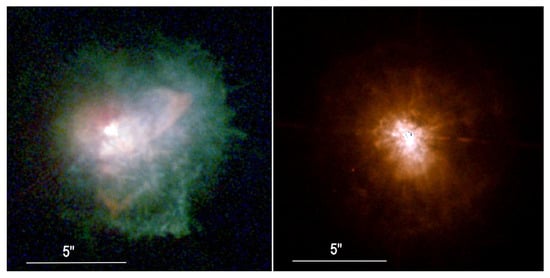
Figure 1
Open AccessArticle
Global Mean-Motion Resonances: Part I—An Exceptional Multiplanetary Resonant Chain in TOI-270 and an Exact Laplace-like Resonance in HD 110067
by
Dimitris M. Christodoulou, Nicholas M. Sorabella, Sayantan Bhattacharya, Silas G. T. Laycock and Demosthenes Kazanas
Galaxies 2025, 13(2), 42; https://doi.org/10.3390/galaxies13020042 - 15 Apr 2025
Abstract
Super-Earth b and sub-Neptunes c and d are orbiting about the M3.0V dwarf TOI-270 in that order from the star. Their global resonant chain (3:5, 1:1, 2:1) is extremely surprising because planet d appears to be the only known planet occupying the 2:1
[...] Read more.
Super-Earth b and sub-Neptunes c and d are orbiting about the M3.0V dwarf TOI-270 in that order from the star. Their global resonant chain (3:5, 1:1, 2:1) is extremely surprising because planet d appears to be the only known planet occupying the 2:1 resonant orbit without participating in a Laplace resonance (LR) or another planet intervening between the 1:1 and 2:1 orbits as in HD 110067. We do not believe that TOI-270 d is an exception to the empirical rule calling for 2:1 vacancy except in 1:2:4 LRs and Laplace-like 2:3:4 chains. Instead, a LR might exist in this system, and we searched (to no avail) the TESS light curves of TOI-270 for hints of an outer planet that would complete the LR chain. Alternative explanations would be an unknown planet more massive than planet c (
(This article belongs to the Collection A Trip across the Universe: Our Present Knowledge and Future Perspectives)
►▼
Show Figures

Figure 1
Open AccessArticle
Global Mean-Motion Resonances: Part II—Laplace-like Phase Angles to Facilitate Libration Searches in Multiplanetary N-body Simulations
by
Dimitris M. Christodoulou, Nicholas M. Sorabella, Sayantan Bhattacharya, Silas G. T. Laycock and Demosthenes Kazanas
Galaxies 2025, 13(2), 41; https://doi.org/10.3390/galaxies13020041 - 14 Apr 2025
Abstract
We describe a method of determining three-body and four-body Laplace-like phase angles with the potential to librate about a mean value in multiplanet extrasolar systems. Unlike in past searches of N-body results, this method relies on global mean-motion resonances (MMRs) and takes into
[...] Read more.
We describe a method of determining three-body and four-body Laplace-like phase angles with the potential to librate about a mean value in multiplanet extrasolar systems. Unlike in past searches of N-body results, this method relies on global mean-motion resonances (MMRs) and takes into consideration the location of the most massive planet that defines the 1:1 global MMR in each (sub)system. We compiled lists of potentially librating phase angles and prevalent MMRs in 35 real multibody systems, and we discuss their properties in conjunction with recent investigations of librations discovered in sophisticated N-body simulations. We hope that our results will facilitate systematic libration searches in dynamical models of compact systems with three or more orbiting bodies.
Full article
(This article belongs to the Collection A Trip across the Universe: Our Present Knowledge and Future Perspectives)
►▼
Show Figures

Figure 1
Open AccessReview
Spectropolarimetry for Discerning Geometry and Structure in Circumstellar Media of Hot Massive Stars
by
Richard Ignace, Kenneth G. Gayley, Roberto Casini, Paul Scowen, Christiana Erba and Jeremy Drake
Galaxies 2025, 13(2), 40; https://doi.org/10.3390/galaxies13020040 - 11 Apr 2025
Abstract
Spectropolarimetric techniques are a mainstay of astrophysical inquiry, ranging from Solar System objects to the Cosmic Background Radiation. This review highlights applications of stellar polarimetry for massive hot stars, particularly in the context of ultraviolet (UV) spaceborne missions. The prevalence of binarity in
[...] Read more.
Spectropolarimetric techniques are a mainstay of astrophysical inquiry, ranging from Solar System objects to the Cosmic Background Radiation. This review highlights applications of stellar polarimetry for massive hot stars, particularly in the context of ultraviolet (UV) spaceborne missions. The prevalence of binarity in the massive star population and uncertainties regarding the degree of rotational criticality among hot stars raises important questions about stellar interactions, interior structure, and even the lifetimes of evolutionary phases. These uncertainties have consequences for stellar population synthesis calculations. Spectropolarimetry is a key tool for extracting information about stellar and binary geometries. We review methodologies involving electron scattering in circumstellar envelopes; gravity darkening from rapid rotation; spectral line effects, including the (a) “line effect”, (b) Öhman effect, and (c) Hanle effect; and the imprint of interstellar polarization on measurements. Finally, we describe the Polstar UV spectropolarimetric SMEX mission concept as one means for employing these diagnostics to clarify the state of high rotation and its impacts for massive stars.
Full article
(This article belongs to the Special Issue Circumstellar Matter in Hot Star Systems)
►▼
Show Figures

Figure 1
Open AccessArticle
Accurate Decomposition of Galaxies with Spiral Arms: Dust Properties and Distribution
by
Alexander A. Marchuk, Ilia V. Chugunov, Frédéric Galliano, Aleksandr V. Mosenkov, Polina V. Strekalova, Sergey S. Savchenko, Valeria S. Kostiuk, George A. Gontcharov, Vladimir B. Il’in, Anton A. Smirnov and Denis M. Poliakov
Galaxies 2025, 13(2), 39; https://doi.org/10.3390/galaxies13020039 - 9 Apr 2025
Abstract
We analyze three nearby spiral galaxies—NGC 1097, NGC 1566, and NGC 3627—using images from the DustPedia database in seven infrared bands (3.6, 8, 24, 70, 100, 160, and 250 μm). For each image, we perform photometric decomposition and construct a multi-component model, including
[...] Read more.
We analyze three nearby spiral galaxies—NGC 1097, NGC 1566, and NGC 3627—using images from the DustPedia database in seven infrared bands (3.6, 8, 24, 70, 100, 160, and 250 μm). For each image, we perform photometric decomposition and construct a multi-component model, including a detailed representation of the spiral arms. Our results show that the light distribution is well described by an exponential disk and a Sérsic bulge when non-axisymmetric components are properly taken into account. We test the predictions of the stationary density wave theory using the derived models in bands, tracing both old stars and recent star formation. Our findings suggest that the spiral arms in all three galaxies are unlikely to originate from stationary density waves. Additionally, we perform spectral energy distribution (SED) modeling using the hierarchical Bayesian code HerBIE, fitting individual components to derive dust properties. We find that spiral arms contain a significant (>10%) fraction of cold dust, with an average temperature of approximately 18–20 K. The estimated fraction of polycyclic aromatic hydrocarbons (PAHs) declines significantly toward the galactic center but remains similar between the arm and interarm regions.
Full article
(This article belongs to the Special Issue From Tides to Waves: Understanding the Formation Mechanisms of Galactic Spirals)
►▼
Show Figures

Figure 1
Open AccessArticle
Non-Zero Coriolis Field in Ehlers’ Frame Theory
by
Federico Re and Oliver F. Piattella
Galaxies 2025, 13(2), 38; https://doi.org/10.3390/galaxies13020038 - 5 Apr 2025
Abstract
Ehlers’ Frame Theory is a class of geometric theories parameterized by
Ehlers’ Frame Theory is a class of geometric theories parameterized by
(This article belongs to the Special Issue From Tides to Waves: Understanding the Formation Mechanisms of Galactic Spirals)
Highly Accessed Articles
Latest Books
E-Mail Alert
News
Topics

Conferences
Special Issues
Special Issue in
Galaxies
Origins and Models of Planetary Nebulae
Guest Editors: Andreas Ritter, Xuan FangDeadline: 10 May 2025
Special Issue in
Galaxies
Alternative Interpretations of Observed Galactic Behaviors
Guest Editors: Anne M. Hofmeister, Robert E. CrissDeadline: 15 May 2025
Special Issue in
Galaxies
Circumstellar Matter in Hot Star Systems
Guest Editors: Anatoly Miroshnichenko, Sergei Zharikov, Serik KhokhlovDeadline: 20 May 2025
Special Issue in
Galaxies
Cosmology and the Quantum Vacuum—2nd Edition
Guest Editors: Emilio Elizalde, Martiros Khurshudyan, Iver H. BrevikDeadline: 10 June 2025
Topical Collections
Topical Collection in
Galaxies
A Trip across the Universe: Our Present Knowledge and Future Perspectives
Collection Editor: Emilio Elizalde






